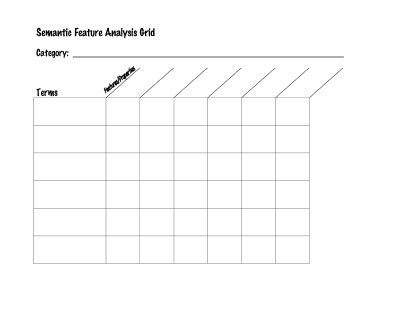Text by: Evangelia Vassilakou
Traditional vocabulary instruction focuses on pre teaching either difficult or low frequency vocabulary. This can cause students to stop reading a text because of unfamiliar words. On the contrary, Semantic Feature Analysis (SFA) departs from a traditional vocabulary approach and effectively develops academic and non-academic vocabulary. It is another way to build conceptual knowledge, by having learners complete and analyze a grid/ matrix. In particular, through a visual representation students are able to see connections, make predictions, compare similar and different words, group vocabulary words into logical categories, build on prior knowledge, discuss to elicit information about word meaning and master important concepts by analyzing a completed matrix.
What research says?
Research suggests that lexical items are learned in groups and not as single items as “individuals tend to recall words according to the categories or semantic fields in which they are conceptually mapped” (Carter, 2012, p. 204). It is also worth mentioning that words may be grouped together in terms of different criteria such as thematic categories (i.e. parts of the body, kinship), or notional concepts (i.e. measurement, movement) or associative relatedness (school-books). Most importantly, the SFA is a powerful method and via the grid approach learners “grasp the uniqueness of individual words” since “it mimics the way the brain organizes information” (Amer, 2019, p.2). In other words, it is essential that vocabulary be viewed as “interrelated semantic networks” rather than “an unstructured list of words” (Amer, 2019, p. 1).
Steps for using the SFA
Language teachers can follow the steps below for using the Semantic Feature Analysis strategy:
Have students read the assigned text.
Vocabulary words should be listed down the left hand column (the names of the members of the category) and the features of the topic across the top row of the chart. Once the matrix outline is complete, review all the words and features with the students and have them carefully read the text selection.
As they read, have students place a “+” sign in the matrix when a vocabulary word aligns with a particular feature of the topic (the example). If the word does not align students may put a “-” in the grid (the non-example). If students are unable to determine a relationship they may leave it blank.
After reading and completing the matrix, have students analyze their completed graphics
Alternatively, teachers can use the Know, Want to Know, Learned (KWL) reading strategy (Amer, 2012, p. 3) when incorporating SFA grids in the EFL classroom. More analytically, before teaching a unit/a text, teachers may begin by using an empty grid - having only the 2 dimensions of the grid, namely the selected words and the features of the topic, on the board or as a photocopiable template to activate learners’ prior knowledge about the given theme. Then they let students brainstorm what they already know. Afterwards, during the lesson, the students read the text to verify their content knowledge included in the grid and complete the grid. Upon completion of the grid, the teachers ask questions to check their students’ level of understanding by asking them to analyze the grid. Suggested questions for teachers are as follows:
How different or similar is A and B?
What are the common features among the members of the category?
What are the common features between A, B, and C?
As a follow up activity, the teacher can ask for a written summary of what students have learned.
Example / screenshot of semantic grids

Concluding remarks
A Semantic Feature Analysis improves students’ comprehension, vocabulary, and content retention. Teachers can use this strategy with the whole class, small groups, or individually. It goes without saying that the right choice of semantic grids entails considering parameters such as the learners’ age, linguistic competence, content subject and prior knowledge. Monitoring each student’s matrix provides teachers with information about how much the students know about the topic. This allows teachers to modify instruction by designing lessons tailored to the needs of the students, help them practice all four skills, stimulate semantic relatedness and subsequently develop their mental lexicon.
References
Amer, A. (2019). Teaching / developing vocabulary using semantic feature analysis framing the issue. DOI:10.1002/9781118784235.eelt 0743
Carter, R. (2012). Vocabulary: Applied linguistic perspectives. New York: Routledge Linguistics Classics.
http://www.adlit.org/strategies/22731/
